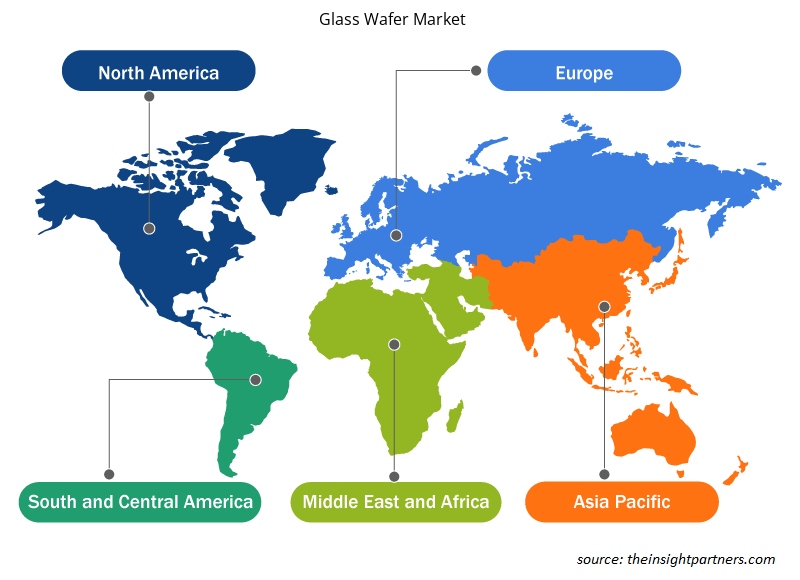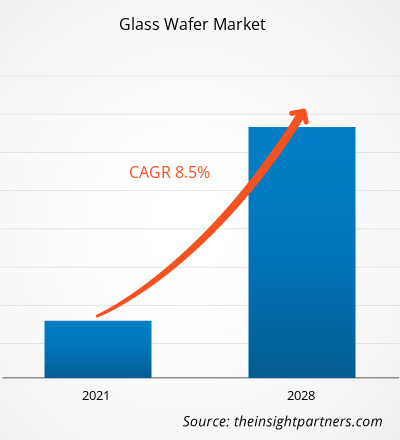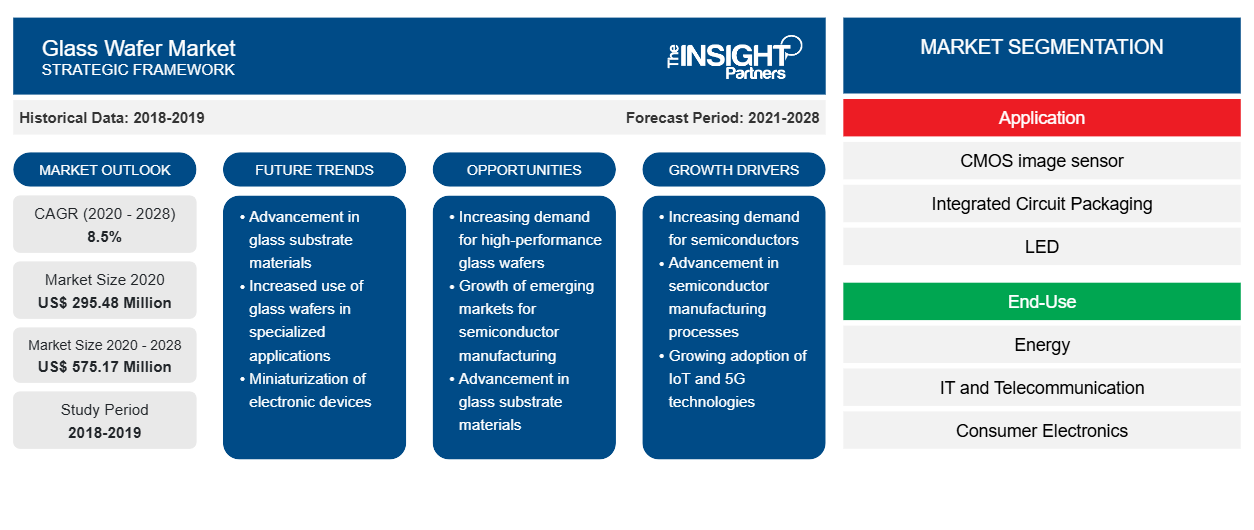Der Markt für Glaswafer hatte im Jahr 2020 einen Wert von 295,48 Millionen US-Dollar und soll bis 2028 einen Wert von 575,17 Millionen US-Dollar erreichen; von 2020 bis 2028 wird mit einer durchschnittlichen jährlichen Wachstumsrate von 8,5 % gerechnet .
Ein Glaswafer ist eine dünne Scheibe, die als Basis für die Herstellung integrierter Schaltkreise und zum Schutz in der Unterhaltungselektronik verwendet wird. Der Glaswafer besteht normalerweise aus Quarz, Borosilikatglas oder Quarzglas. Diese Wafer werden in einer Vielzahl von industriellen und technischen Anwendungen eingesetzt. Borosilikatglaswafer bieten eine höhere chemische Stabilität gegenüber Wasser oder anderen Chemikalien. Die steigende Nachfrage nach kompakten und fortschrittlichen Unterhaltungselektronikgeräten wird das Wachstum des Glaswafermarktes vorantreiben. Die steigende Nachfrage nach Automobilelektronik aufgrund von Elektro- und Hybridfahrzeugen wird zu einer steigenden Nachfrage nach Glaswafern führen.
Im Jahr 2020 hatte der asiatisch-pazifische Raum den größten Anteil am globalen Markt für Glaswafer. Die Dominanz dieser Region ist vor allem auf das schnelle Wachstum der Automobil- und Elektronikindustrie in der Region zurückzuführen. Das exponentielle Wachstum des Industriesektors, einschließlich Automobil, Medizin und anderen, hat die Nachfrage nach Glaswafern beeinflusst. Asien ist eine der führenden Regionen für die Herstellung von Elektro- und Elektronikprodukten.
Der Ausbruch von COVID-19 wurde erstmals im Dezember 2020 in Wuhan (China) gemeldet. Im Januar 2021 gehörten die USA, Indien, Brasilien, Russland, Frankreich, das Vereinigte Königreich, die Türkei, Italien und Spanien hinsichtlich bestätigter Fälle und gemeldeter Todesfälle zu den am schlimmsten betroffenen Ländern. Laut den jüngsten Zahlen der WHO vom Januar 2021 gibt es weltweit ca. 83.322.449 bestätigte Fälle und insgesamt 1.831.412 Todesfälle. Der Ausbruch wirkt sich aufgrund von Ausgangssperren , Reiseverboten und Geschäftsschließungen nachteilig auf die Volkswirtschaften und Industrien zahlreicher Länder aus. Die globale Chemie- und Werkstoffindustrie ist einer der wichtigsten Wirtschaftszweige, die unter schwerwiegenden Störungen wie Unterbrechungen der Lieferkette, Absagen von Technologieveranstaltungen und Büroschließungen leidet. Obwohl China das globale Produktionszentrum und der größte Rohstofflieferant für verschiedene Industrien ist, ist es auch eines der am schlimmsten betroffenen Länder. Die Schließung zahlreicher Werke und Fabriken in China schränkt die globalen Lieferketten ein und stört die Produktionsaktivitäten, Lieferpläne sowie den Verkauf verschiedener Chemikalien und Werkstoffe. Verschiedene Unternehmen haben bereits mögliche Verzögerungen bei Produktlieferungen und einen Einbruch des zukünftigen Verkaufs ihrer Produkte angekündigt. Darüber hinaus behindern die von Ländern in Europa, Asien und Nordamerika verhängten weltweiten Reiseverbote die Möglichkeiten für geschäftliche Kooperationen und Partnerschaften. All diese Faktoren behindern die Chemie- und Materialindustrie und bremsen somit das Wachstum verschiedener mit dieser Industrie verbundener Märkte.
Passen Sie diesen Bericht Ihren Anforderungen an
Sie erhalten kostenlos individuelle Anpassungen an jedem Bericht, einschließlich Teilen dieses Berichts oder einer Analyse auf Länderebene, eines Excel-Datenpakets sowie tolle Angebote und Rabatte für Start-ups und Universitäten.
-
Holen Sie sich die wichtigsten Markttrends aus diesem Bericht.Dieses KOSTENLOSE Beispiel umfasst eine Datenanalyse von Markttrends bis hin zu Schätzungen und Prognosen.
Markteinblicke
Steigende Nachfrage nach MEMs
Aufgrund ihrer Anwendung in Kommunikationssystemen, Automobilsensoren sowie tragbaren medizinischen Geräten steigt die Nachfrage nach mikroelektromechanischen Systemen ( MEMS ) weltweit. Aufgrund ihres Miniaturdesigns sind diese MEMs für den Einsatz in allen elektronischen Geräten geeignet, was ihre Anwendung verstärkt hat . Aufgrund ihrer überlegenen Funktionalität, Zuverlässigkeit und Fähigkeit, rauen Umgebungen standzuhalten, werden Glaswafer hauptsächlich für die Waferverpackung empfindlicher Komponenten verwendet. Aufgrund ihrer chemischen Beständigkeit und thermischen Stabilität werden diese Glaswafer auch als Trägersubstrate verwendet. Die Nachfrage nach tragbaren medizinischen Geräten, zu denen auch Geräte zur Patientenüberwachung gehören, ist während der Pandemie aufgrund der verstärkten Nutzung und Nachfrage durch medizinisches Personal auf der ganzen Welt gestiegen. Die COVID-19-Pandemie hat die Nachfrage der Verbraucher nach persönlichen Überwachungsgeräten angekurbelt. Diese Geräte sind mit MEMS integriert . Daher steigt die Nachfrage nach MEMs , was wiederum das Wachstum des Glaswafermarktes vorantreibt.
Anwendungseinblicke
Basierend auf der Anwendung ist der Glaswafermarkt in CMOS- Bildsensor, integrierte Schaltkreise ( IC )-Verpackung, LED, Mikrofluidik , FO-WLP sowie MEMS und RF segmentiert. Das Segment der CMOS- Bildsensoren war 2020 mit dem größten Anteil der Marktführer. Ein Bildsensor oder Imager ist ein Sensor, der Informationen erkennt und überträgt, die zur Erzeugung eines Bildes verwendet werden. Es gibt zwei Arten von elektronischen Bildsensoren: ladungsgekoppelte Bauelemente ( CCD ) und Aktivpixelsensoren ( CMOS- Sensor). Ein Aktivpixelsensor ist ein Bildsensor, bei dem jeder Pixelsensor über einen Fotodetektor verfügt . Zu den verschiedenen Arten von Aktivpixelsensoren gehören der frühe NMOS -APS und der gängigen Art, der komplementäre MOS( CMOS ) -APS , der als CMOS- Sensor bekannt ist und weit verbreitet in der Digitalkameratechnik sowie in Mobiltelefonen verwendet wird. CMOS- Bildsensoren haben verschiedene Eigenschaften wie niedrigen Stromverbrauch, hohe Integration und schnelle IO-Auslesegeschwindigkeit, weshalb sie zu einem der am weitesten verbreiteten Sensoren geworden sind.
Einige wichtige Marktteilnehmer auf dem Markt für Glaswafer sind SCHOTT AG, AGC Inc., Corning Incorporated, Plan Optik AG, Shin-Etsu Chemical Co., Ltd, Samtec , Inc, Bullen , Nippon Electric Glass, Swift Glass und Coresix Precision Glass, Inc. Die wichtigsten Marktteilnehmer konzentrieren sich auf Strategien wie Fusionen und Übernahmen sowie Produkteinführungen, um ihre geografische Präsenz und Kundenbasis weltweit auszuweiten.
Regionale Einblicke in den Glaswafermarkt
Die regionalen Trends und Faktoren, die den Glaswafermarkt im Prognosezeitraum beeinflussen, wurden von den Analysten von Insight Partners ausführlich erläutert. In diesem Abschnitt werden auch die Marktsegmente und die Geografie des Glaswafermarkts in Nordamerika, Europa, im asiatisch-pazifischen Raum, im Nahen Osten und Afrika sowie in Süd- und Mittelamerika erörtert.

- Erhalten Sie regionale Daten zum Glaswafermarkt
Umfang des Marktberichts für Glaswafer
| Berichtsattribut | Details |
|---|---|
| Marktgröße im Jahr 2020 | 295,48 Millionen US-Dollar |
| Marktgröße bis 2028 | 575,17 Millionen US-Dollar |
| Globale CAGR (2020 - 2028) | 8,5 % |
| Historische Daten | 2018-2019 |
| Prognosezeitraum | 2021-2028 |
| Abgedeckte Segmente |
Nach Anwendung
|
| Abgedeckte Regionen und Länder |
Nordamerika
|
| Marktführer und wichtige Unternehmensprofile |
|
Dichte der Marktteilnehmer für Glaswafer: Auswirkungen auf die Geschäftsdynamik verstehen
Der Markt für Glaswafer wächst rasant, angetrieben durch die steigende Nachfrage der Endverbraucher aufgrund von Faktoren wie sich entwickelnden Verbraucherpräferenzen, technologischen Fortschritten und einem größeren Bewusstsein für die Vorteile des Produkts. Mit steigender Nachfrage erweitern Unternehmen ihr Angebot, entwickeln Innovationen, um die Bedürfnisse der Verbraucher zu erfüllen, und nutzen neue Trends, was das Marktwachstum weiter ankurbelt.
Die Marktteilnehmerdichte bezieht sich auf die Verteilung der Firmen oder Unternehmen, die in einem bestimmten Markt oder einer bestimmten Branche tätig sind. Sie gibt an, wie viele Wettbewerber (Marktteilnehmer) in einem bestimmten Marktraum im Verhältnis zu seiner Größe oder seinem gesamten Marktwert präsent sind.
Die wichtigsten auf dem Glaswafermarkt tätigen Unternehmen sind:
- SCHOTT
- AGC Inc.
- Corning Incorporated
- Plan Optik AG
- Bullen
Haftungsausschluss : Die oben aufgeführten Unternehmen sind nicht in einer bestimmten Reihenfolge aufgeführt.

- Überblick über die wichtigsten Akteure auf dem Glaswafermarkt
Bericht-Spotlights
Progressive Branchentrends in der globalen
- Glaswafer-Markt, um den Akteuren bei der Entwicklung wirksamer langfristiger Strategien zu helfen
- In Industrie- und Entwicklungsländern angewandte Strategien für Unternehmenswachstum
- Quantitative Analyse des globalen Glaswafermarktes von 2017 bis 2028
- Schätzung der Nachfrage nach Glaswafern in verschiedenen Branchen
- PEST-Analyse zur Veranschaulichung der Wirksamkeit der in der Branche tätigen Käufer und Lieferanten bei der Vorhersage des Marktwachstums
- Aktuelle Entwicklungen zum Verständnis des Wettbewerbsmarktszenarios und der Nachfrage nach Glaswafern
- Markttrends und -aussichten in Verbindung mit Faktoren, die das Wachstum des Glaswafermarktes vorantreiben und bremsen
- Entscheidungsprozess durch das Verständnis von Strategien, die das kommerzielle Interesse im Hinblick auf das Wachstum des globalen Glaswafermarktes untermauern
- Größe des Glaswafermarktes an verschiedenen Marktknoten
- Detaillierte Übersicht und Segmentierung des globalen Glaswafermarktes sowie seiner Dynamik in der Branche
- Marktgröße für Glaswafer in verschiedenen Regionen mit vielversprechenden Wachstumschancen
Glaswafermarkt, nach Anwendung
- CMOS-Bildsensor
- Verpackung integrierter Schaltkreise (IC)
- LED
- Mikrofluidik
- FO-WLP
- MEMS und RF
- Sonstiges
Glaswafer-Markt nach Endverbrauch
- Energie
- IT und Telekommunikation
- Unterhaltungselektronik
- Luft- und Raumfahrt und Verteidigung
- Automobilindustrie
- Gesundheitswesen und Biotechnologie
- Sonstiges
Firmenprofile
- SCHOTT AG
- AGC Inc.
- Corning Incorporated
- Plan Optik AG
- Shin-Etsu Chemical Co., Ltd
- Samtec, Inc.
- Bullen
- Nippon Elektroglas
- Swift-Glas
- Coresix Precision Glass, Inc
- Historische Analyse (2 Jahre), Basisjahr, Prognose (7 Jahre) mit CAGR
- PEST- und SWOT-Analyse
- Marktgröße Wert/Volumen – Global, Regional, Land
- Branchen- und Wettbewerbslandschaft
- Excel-Datensatz
Aktuelle Berichte
Verwandte Berichte
Erfahrungsberichte
Grund zum Kauf
- Fundierte Entscheidungsfindung
- Marktdynamik verstehen
- Wettbewerbsanalyse
- Kundeneinblicke
- Marktprognosen
- Risikominimierung
- Strategische Planung
- Investitionsbegründung
- Identifizierung neuer Märkte
- Verbesserung von Marketingstrategien
- Steigerung der Betriebseffizienz
- Anpassung an regulatorische Trends























 Kostenlose Probe anfordern für - Markt für Glaswafer
Kostenlose Probe anfordern für - Markt für Glaswafer